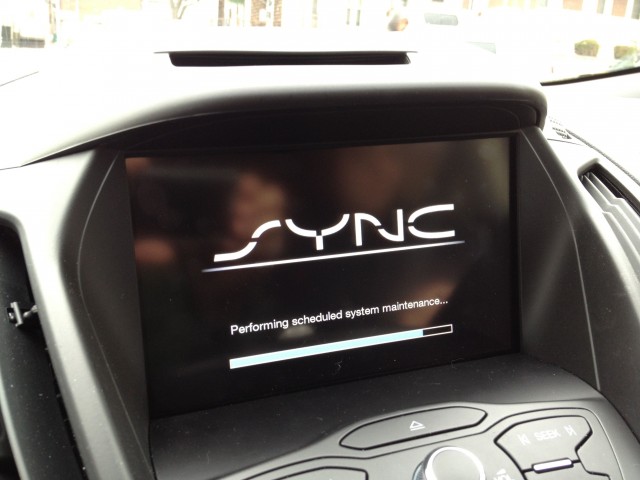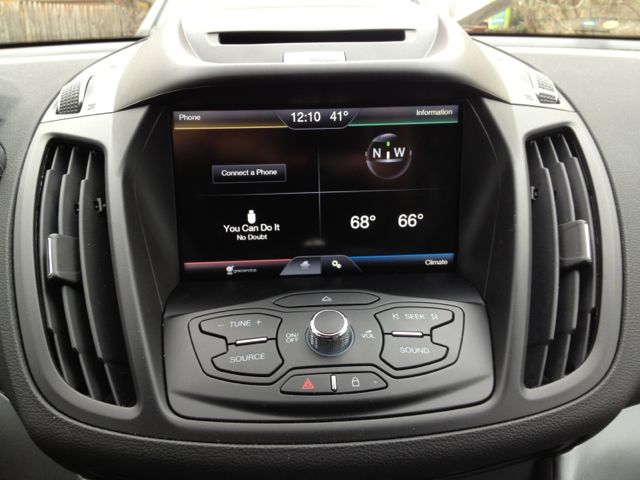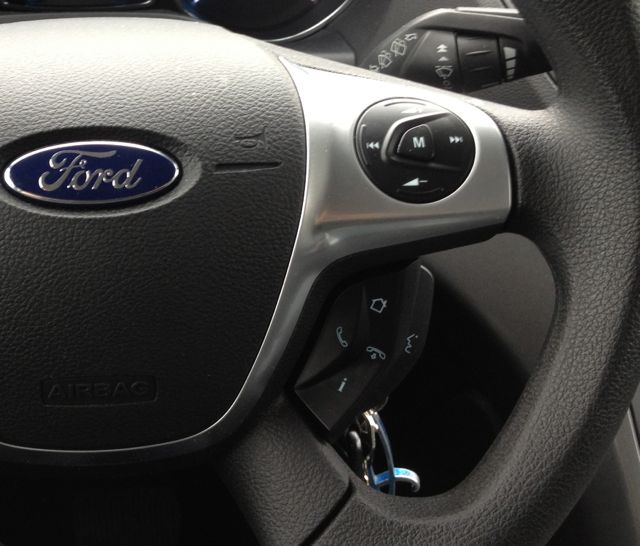
MyFord Touch and Sync performing surprise "scheduled system maintenance."
According to the Centers for Disease Control, about 1.3 million people die every year as the result of car crashes—and driver distraction being a rapidly growing factor in those crashes. In a study released last week, the CDC found that nearly a third of drivers in the US text while driving. More than two-thirds admit to talking on their cell phones while driving.
What the study didn't reveal is how many people are driven to distraction by the in-car technology that's supposed to, in theory, reduce driver distraction. It didn't determine how many accidents have been caused by someone having to reboot their in-car entertainment system at a stop light by shutting off the engine and opening their car door—the MyFord Touch equivalent of a hard reboot.
In early February, I bought a 2013 Ford Escape equipped with MyFord Touch. In many ways, the system, which was developed jointly by Ford and Microsoft, is a driver's best friend. But best friends can be idiosyncratic sometimes, and they occasionally drive you nuts—especially when they argue with your other best friends (like your smart phone). These friends occasionally stop talking to each other, and one might even interrupt calls to your mom because they've decided it's time to perform "routine maintenance."
Ford and GM have been making a big deal about the future of the "connected car" lately, and the two companies are trying to bring more and more smartphone functionality to the dashboards of their vehicles in order to help keep the always-on generation tethered to the Internet teat. The problem is that smart phones (and their apps) and cars have slightly different life cycles. There's no way the auto makers can ever catch up with smart phones if they keep trying to focus everything around their own brands and technology.
It would help, at least, if they were a little less kludge-like. (I mean, we were supposed to have flying cars by now—at least according to Back to the Future...)
No Knight Rider
Sure, the "connected car" has become a focus for both Ford and GM recently. As I've written, GM is increasingly API-enabling its OnStar communications platform to allow Web and phone apps to interact with OnStar-equipped vehicles. Ford has sponsored OpenXC, an open-source application programming interface that taps into vehicles' Controller Area Network (CAN) through the On-Board Diagnostics-II (OBD-II) port. And that port is standard on all cars sold in the US since 1996 thanks to EPA emissions testing requirements. Both Ford and GM even recently announced developer programs to bring "apps" to their in-vehicle entertainment systems (Ford's Sync AppLink and GM's MyLink and IntelliLink).
But there has been little room for Mr. Fusion style car hacking in the agendas of the big auto makers—the apps still need to run within the sandbox of GM's and Ford's chosen platforms. We're not even close to having Kit the Wonder Car yet, unless you're a Google employee. Or maybe you count the sharp-toned female voice of MyFord Touch's hands-free command system as witty banter. (It's worth noting that the responses from MyFord Touch to voice commands are sometimes accidentally witty. For instance: in response to curses as I tried to navigate the voice command tree to get my iPod Nano to play, the system tuned to Sirius XM's "The Spa" easy listening/ambient channel.)
Touched by an angel
MyFord Touch is the second generation of Ford's Sync platform. And as the name hints, its most notable feature is a touchscreen, which replaces the array of buttons that made up the console interface of the first-gen Sync platform.
But while it's somewhat more intuitive than its predecessor, the MyFord Touch interface is not exactly what one would call the paragon of touch usability. It's also not something any driver should mess with while in motion.

The home screen for MyFord Touch Sync. Want a feature? Just touch the text in the corner...while you're parked. My iPhone is still being indexed here, like it always is.

The Media screen, from which we select our source of entertainment. There are three screens each of presets for AM, FM, and Sirius XM. Navigating presets while driving could end badly—stick to the voice commands and the steering wheel buttons.
To keep the driver from focusing on touchscreen presses, and potentially taking out a row of pedestrians in the process, the Sync system's interface also includes a set of steering wheel buttons intended to speed through the interface without taking hands off the wheel. Drivers can also invoke the voice recognition interface. And the same system is used to contact Sync "services," the voice response phone service that is Ford's answer to OnStar.

The Sync steering wheel button cluster, with media navigation on the gamepad-like cluster; phone, voice commands, and a trip back to the home screen on the multidirectional rocker below.
While Sync tethers to phones over Bluetooth, the Escape offers two USB ports for tethering media devices. Plug a compatible USB broadband modem into one of them, and you can turn the car into a Wi-FI hotspot. There's also an SD card slot; in the version of MyFord Touch equipped with a navigation system, this is for loading maps as well as music.
The voice commands recognized by Sync are limited to a tree of choices based on specific entertainment or service functions. When you misspeak, Sync's tech-matron voice gives you a long lecture on how you should phrase your request, then it offers a menu of possible commands by function also displayed on the touch screen.
That's not to say that Ford's interfaces are impossible. Within about three minutes of being handed the keys, and while the salesman was still fetching my temporary tags, I had figured out the essentials of tethering my phone via Bluetooth and was well on the way to Sync mastery. The problems would begin later when I tethered my iPhone 4S, and then my iPod Nano, to the system through its USB ports.
It must be time for an update
With the iPhone, the issue turned out to be simply a matter of bandwidth. Most of my driving, thanks to my urban lifestyle, is for trips less than 20 minutes long. My morning commute consists of driving five miles roundtrip to my daughter's school and back. So Sync, it seemed, was never completing its indexing of the phone's song contents. Having iTunes Match turned on didn't help matters, but I had the same problem with my Nano once I started using it as my default in-car music device.
Sometimes, Sync would never recognize the device plugged into the USB, or it would have amnesia about the contents of the music device after a phone call. If I unplugged the phone from USB and got out of the car, any indexing in progress would be forgotten. And all of this came after installing a software utility to make sure my iTunes library was properly configured for Sync.

No USB device found—my iPod and Sync are no longer on speaking terms.
Then, in early March, the crashes began. I was on the phone when Sync decided this was the ideal time to reboot, ending my hands-free call. Then it wouldn't recognize the phone at all until I did the simulated-end-of-trip by putting the Escape in park at a red light, turning off the ignition, and opening the door to shut down the system.
After that, the Sync "performing routine maintenance" screen would appear at the least convenient moments. It was clear that whatever it was trying to do, I was not giving it enough quality time with my phone tethered for the system to complete what it was doing. So I decided it was time to check for an update.
The Sync website provides a way to download updates to a USB flash drive for installation. The problem is that it requires a Java plugin or an ActiveX to run. I've been pretty diligent about removing the Java plugin from all my browsers for security reasons RB readers may be aware of. And as an early adopter, I discovered Internet Explorer 9 did not tolerate Ford's ActiveX control.
The download, once I got it installed, was two CAB files totaling no more than 90 kilobytes. Yes, you read that right—kilobytes. I looked at my pseudo-4G iPhone 4S. I looked at the files on the stick that it had taken me half an hour of reconfiguration to get installed. And I shook my head.

Installing the 28-kilobyte update CAB from that Sync had been trying to install for two weeks over the air.
In an era where I stream music from the cloud to my phone and download full smartphone or tablet operating system upgrades in the span of my morning commute, I had to download 90k of data to a FAT-formatted USB stick to install an update properly (which afterward, the Sync site confirmed I had properly installed, thanks to a message sent through my phone over its Bluetooth connection). I can only imagine what it would take to push the full update of the MyFord Touch version of Sync over my Bluetooth connection when Ford eventually issues an update to make it compatible with the AppLink API platform.
No car is an island
This might have been faster if I had turned on Wi-Fi sharing on my iPhone. But that sort of gets to the heart of the problem with the approach taken by Ford and GM—the features they are trying to bring to the dashboard are already in most smartphones, and the in-car systems will just continue to fall behind what you can get out of applications on iOS, Android, or even BlackBerry and Windows Phone. The fact that you can surf the Web on MyFord Touch when parked and using a USB keyboard speaks to a mindset about what a connected vehicle should be—a mindset that is almost a decade old.
GM has acknowledged this, sort of, in its move to integrate into iPhones' Siri on one model of an electric car. Ford has an opportunity with the AppLink platform to get out of the way of software developers and car owners, but it could go much further if the company just focused on providing the one thing that it won't be constantly outpaced in by the consumer electronics industry: the car itself as a platform.
As it is right now, there are no "apps" I can download to MyFord Touch and Sync other than the software updates they issue. And in many ways, that's fine. I use my iPhone for most of the app functions as it is—I use MotionX GPS Drive for navigation, for example, and the turn-by-turn directions get played over the car's speakers just as they would if I had opted for Sync navigation. I have no desire to use the 8-inch screen and a USB wireless modem to check e-mail when parked when I can do it on my phone or a tablet just as easily.
But Ford has the inkling of a good idea with OpenXC. It could take that openness one more step and open the space occupied by Sync now to developers who will better integrate the mobile platforms people already use. Then maybe, I won't have to ask for the one button not currently on the steering wheel: a CTRL-ALT-DELETE combo key.
No comments:
Post a Comment
Let us know your Thoughts and ideas!
Your comment will be deleted if you
Spam , Adv. Or use of bad language!
Try not to! And thank for visiting and for the comment
Keep visiting and spread and share our post !!
Sharing is a kind way of caring!! Thanks again!